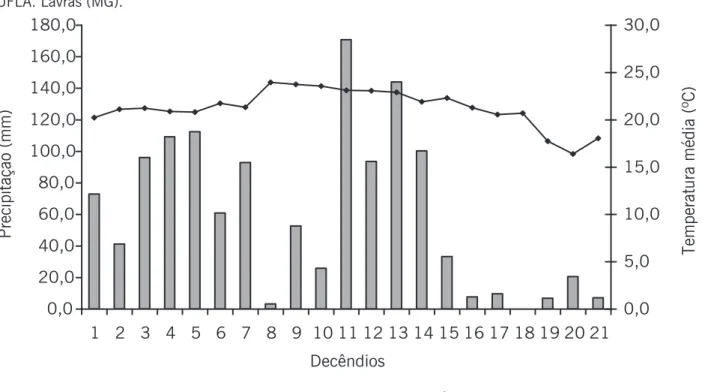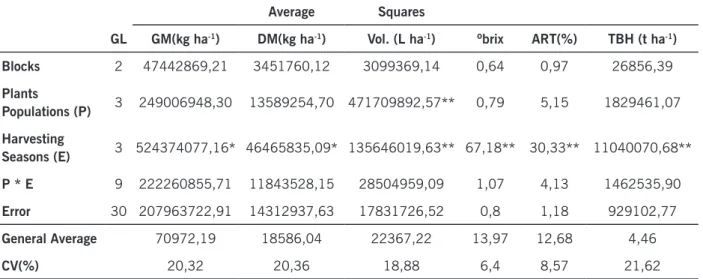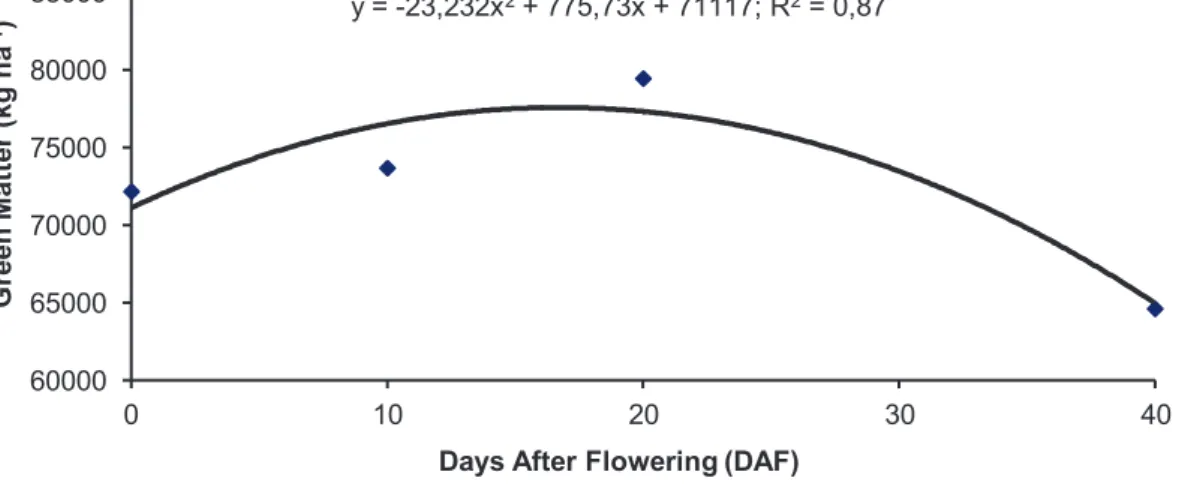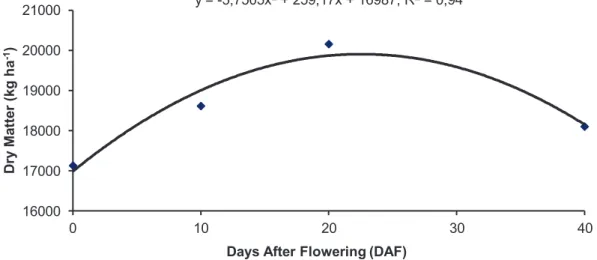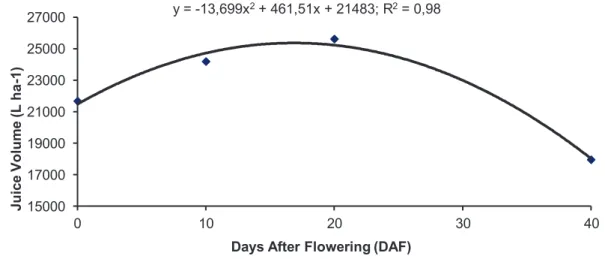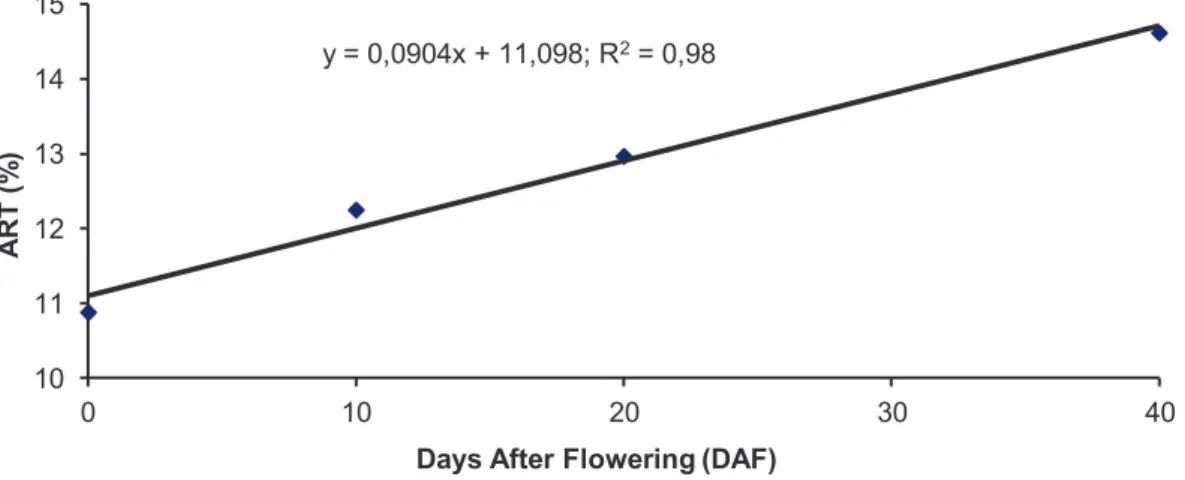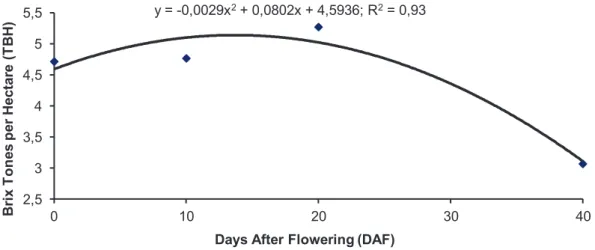Plants population and harvesting times influence in
saccharine sorghum BRS 506 production
Ivan Vilela Andrade Fiorini1 Renzo Garcia Von Pinho2 Hélcio Duarte Pereira3 João Paulo Martins Moraes4
Jhonathan Pedroso Rigal dos Santos5 Iran Dias Borges6
Luiz Paulo Miranda Pires7
Abstract
Saccharine sorghum is an excellent option for ethanol production under industrial and agronomic perspectives, due to high green matter production and succulent stalks with fermentable sugars. The aim of this work was to evaluate the harvesting season and plants population effect over the ethanol and fodder production from sweet sorghum culture BRS 506. The experiment was installed in November 2012, at (CDTCA/UFLA), located in Lavras (MG). The experimental design was in randomized blocks, with 3 repetitions, factorial scheme 4 x 4 (4 populations: 70, 100, 130 and 160 thousand plants ha-1 ; 4 harvesting seasons: flowering (0 days after flowering (DAF), 10 DAF, 20 DAF
and physiological maturity at 40 DAF). The variables evaluated at harvesting: green matter weight (GM), dry matter weight (DM), juice volume (JV), total soluble solids (ºbrix), total reducing sugars (TRS) and brix tonnes per hectare (TBH). The populations increase provided the highest JV and it has not affected other variables. The characteristics were influenced by the harvesting seasons. The harvesting season at 40 DAF provided the highest ºbrix. The ºbrix and the TRS showed linear growth with an increase after flowering for plants harvesting. The highest productivities (GM, DM, JV and TBH) were obtained close to 17, 22, 17 and 14 DAF, respectively, favoring higher fodder and ethanol production in these stages.
Keywords: Biofuels. Brix. Ethanol Production. Fodder production. Sorghum bicolor L.
Introduction
Saccharine sorghum possess height superior to 3 meters, which is ease of mechanization, fast production cycle, high mass production. The residual bagasse can also be used for silage production or energy and ethanol of second generation production (RUBIN, 2008; DURÃES, 2011; ALBUQUER-QUE et al.; 2012). Similarly to sugar cane, that has rich contents of sucrose on the stalks, saccharine
1 Universidade Federal do Mato Grosso, Campus Sinop, pesquisador associado. ivanvaf@yahoo.com.br. Avenida Jacarandás, 6471, Parque das Ararás, Sinop, Mato Grosso, CEP 78.557-456.
2 Universidade Federal de Lavras, Departamento de Agricultura, professor. renzo@dag.ufla.br. 3 Universidade Federal de Lavras, mestrado em Fitotecnia. hhelciopassos@yahoo.com.br. 4 Universidade Federal de Lavras, graduando em Agronomia. jaopmoraes@hotmail.com. 5 Universidade Federal de Lavras, mestrado em Genética UFLA. jhonathanpedroso@yahoo.com.br 6 Universidade Federal de Lavras, doutorado em Fitotecnia UFLA. idb@ufsj.edu.br
sorghum is rich on fermentable sugars. This characteristic presents sorghum as an alternative to pro-duce bioethanol by fermentation process of these sugars, using enzymes responsible for the hydrolysis of sucrose (NAIK et al., 2010; KIM; DAY, 2010; RATNAVATHI et al., 2010; PURCINO, 2011).
Since 2003 in Brazil, it has become common to use flex fuel vehicles fueled with ethanol or gasoline. There is considerable encouragement regarding researches about renewable power sources due to the increasing power demand, contributing to the reduction of non-renewable sources consumption, generating then a higher balance between CO2 production and consumption in nature. Ethanol is responsible for 90 % of total biofuels produced in different parts of the world (ALMODARIS; HADI, 2009; CUNHA; SEVERO FILHO, 2010; PRABU; MURUGESAN, 2011).
Saccharine sorghum can be applied as raw material complementary to sugar cane for ethanol production, in the inter-harvesting period (March and April), when sugar cane fields present low sucrose concentration in the stalks due to plant immaturity (AZEVÊDO et al., 2003; FERNANDES et al., 2003). The challenge to ethanol production which operates eight months per year, with four-months inter-harvesting periods is to be viable and sustainable economically. In this scenario, saccharine sorghum performs as a cultivation alternative in the inter-harvesting period to increase the ethanol productive chain, with the potential to diminish machinery idleness during this period, for the reason that the same milling, fermentation and distillation machinery can be used at ethanol production from sugar cane.
Amongst cultivation practices applied for obtaining higher vegetable production, the choice of better plants population is important because it enhances the efficiency in environment resources exploitation, as electricity and water, and it reduces the competition with invasive plants (PEREIRA FILHO et al., 2013; ALBUQUERQUE et al, 2012; MAY et al., 2012). Besides, plants harvesting season should also be considered, since photo-assimilated compounds accumulation and translocation during the sorghum plant growth and development is considerably variable, requiring an identification of the best harvesting seasons aiming an efficient ethanol production and higher fodder yield (TEIXEIRA et al., 1999; PIRES et al., 2006).
In Brazil, studies related to saccharine sorghum cultivation management are scarce, specifically regarding culture behavior in different plant populations and harvesting seasons, aiming fodder yield and also related to ethanol production. The multiplicative rate TBH (brix tonnes per hectare) was applied in plant population and harvesting seasons aiming to estimate the saccharine sorghum ethanol productivity. The TBH have been highlighted in selected superior genotypes in saccharine sorghum improvement programs for embracing characters which really directly influence in ethanol production per hectare, main focus of saccharine sorghum utilization (SOUZA et al., 2013).
Therefore, the objective was to evaluate the saccharine sorghum/fodder culture BRS 506 in terms of characteristics related to fodder yield and ethanol production according to plants populations and harvesting seasons.
Material and methods
The experiment was installed on November 22, 2012 at the Center of Scientific and Technological Development in Agriculture (CDTCA/UFLA), located in Lavras (MG), under no-tillage, in soil classified as Distroferric Yellow Red Latosol, clay texture and slope of 9 % declivity (SANTOS et al., 2013). The municipality weather is classified as mesothermal, with annual average temperatures of 19.3 ºC, 1.411 mm average annual precipitation, with 70 % total concentrated between December and March. The development of the experiment occurred in an incidence period of normal temperatures, intensity and distribution of rain in the region (Figure 1).
Figure 1. Average data of temperature and pluviometry precipitation per 10-day period, in Lavras (MG), from 11/01/2012 to 05/31/2013. Data obtained at UFLA’s sector of Bioclimatology. Agricultural year 2012/13. UFLA. Lavras (MG).
Source: Elaborated by the authors.
The results obtained with the chemical analysis from this soil (0-20 cm depth) were: pH in H2O = 5.7; P = 11.1 mg dm-3; K = 109 mg dm-3; Ca = 39 mmol
c dm-3; Mg = 12 mmolc dm-3; V%
= 57.1; organic matter = 30 g kg-1, S-SO-4 = 9.8 mg dm-3. Fertilization was calculated to provide
appropriate nitrogen, phosphorus and potassium quantities, based on the expectation of obtaining high silage productivity, above 60 tonnes ha-1 of green matter (RIBEIRO et al., 1999). In every
treatment it was used 375 kg ha-1 of 8-28-16+0.5% Zn in sowing fertilization and 460 kg ha-1 of
30-00-20 in top dressing fertilization, 25 days after emergence. The experimental area was previously cultivated for five years with corn as monoculture.
The experimental design was randomized blocks, with 3 repetitions, factorial scheme 4 x 4 (4 populations: 70, 100, 130 and 160 thousand plants ha-1; 4 harvesting seasons: 0 days after flowering
(DAF), 10 DAF, 20 DAF and physiological maturity at 40 DAF). The double aptitude culture saccharine/ fodder BRS 506 was used, considering flowering 81 days after emergence. The experimental plot consisted of four rows of 4 m with the respective plant population and spacing 0.6 m, considering the two central lines as the useful area.
The area was dissected using herbicide with the active ingredient Glyphosate with dosage of 3L ha-1 15 days before sowing. A double of the recommended number of seeds was sown to
plant populations. The weed control was performed in the post emergence 25 days after sorghum sowing using Atrazine in the dosage of 4L ha-1, with manual weeding at 40 days after emergence to
control monocotyledon weeds. The thinning for plant populations was performed 30 days after the emergence of the plants. The insecticide with active ingredient Deltametrine in the dosage of 250ml ha-1 was used for insect control 50 days after sorghum emergence.
The evaluated parameters in each harvesting season were: a) total green matter weight (GM): weight of the main stem, plus the sum of leaves and panicles of the plants harvested in the plot area,
in a scale of the dynamometer type, Filizolla brand. The obtained values were expressed in kg ha-1; b)
total dry matter weight (DM): pre samples drying of about 300 grams from fresh matter chopped in a greenhouse with forced ventilation system at 65 ºC until steady weight, and weighting using an analytical scale, brand Filizolla. The resulting values, based on the green matter obtained, were expressed in kg ha-1; c) juice volume: (JV): determined by juice volume measurement of a sample at random of eight
stalks harvested at the useful portion, extracted in electric motor grinding Model B-728 Inox Roll 220v considered “low extraction efficient” and estimated considering the respective plants population at the portion. The stalks were processed two times in the extraction, and at the second time they were folded in half to obtain a higher juice extraction and the values were expressed ºbrix; e) total reducing sugars (TRS): determined by the Somogoy method, adapted by Nelson (1944); f) brix tonnes per hectare (TBH): determined from multiplication between productivity of stalks green matter per hectare, juice extraction percentage and total soluble solids (average ºbrix), expressed in tonnes ºbrix ha-1.
Without restriction to the presupposition of variation analysis, data were submitted to the variation analysis by the test F (p < 0.05). With the F test significative, the regression has proceeded with the support of the statistical software SISVAR (Ferreira, 2011). The models to adjust the equations were chosen based on the significance effects and determination coefficient.
Table 1. Variation analysis overview for the characteristics: green matter weight (GM), dry matter weight (DM), juice volume (Vol.), total soluble solids (ºbrix), total reducing sugars (ART), sucrose (SAC) and tonnes brix per hectare (TBH). Agricultural year 2012/13. UFLA. Lavras (MG).
Average Squares
GL GM(kg ha-1) DM(kg ha-1) Vol. (L ha-1) ºbrix ART(%) TBH (t ha-1)
Blocks 2 47442869,21 3451760,12 3099369,14 0,64 0,97 26856,39 Plants Populations (P) 3 249006948,30 13589254,70 471709892,57** 0,79 5,15 1829461,07 Harvesting Seasons (E) 3 524374077,16* 46465835,09* 135646019,63** 67,18** 30,33** 11040070,68** P * E 9 222260855,71 11843528,15 28504959,09 1,07 4,13 1462535,90 Error 30 207963722,91 14312937,63 17831726,52 0,8 1,18 929102,77 General Average 70972,19 18586,04 22367,22 13,97 12,68 4,46 CV(%) 20,32 20,36 18,88 6,4 8,57 21,62
*,** significant at 5 % and 1 % probability by the F test, respectively. Source: Elaborated by the authors.
With the increase of plants populations, there were increments on the values of total green matter weight productivities, however, there were no significative differences, possibly by the compensatory effect of tillering in sorghum culture population’s reduction. It was reported on sorghum by Montagner, Lovato and Garcia (2004) an increase in grain production and green matter with the reduction at the initial plants populations, this way, sorghum compensated the number of plants reduction in 112000 plants ha-1. This behavior may be extrapolated to saccharine sorghum which has very similar
physiological characteristics, being necessary, however, the identification and measurement of the stand compensation aspect. The lower plant populations due to the greater light incidence in the line showed high tillering, with the effect of compensation in the plant stand, not differing from the larger populations evaluated. These results corroborate the results obtained by several authors in works with saccharine sorghum populations (PEREIRA FILHO et al., 2013; ALBUQUERQUE et al., 2012; MAY
et al., 2012), at which the biggest total green matter populations, mass or juice volume occurred in the biggest plant populations.
In conducted work with saccharine sorghum, concerning different plants arrangements and two cultures, Albuquerque et al. (2012) verified that the increase of plants populations caused the higher values in green matter and dry matter productivity, but there were no significative differences, corroborating the results obtained in the study.
In green matter weight production with the harvesting seasons advance, it is noted that the maximum value point obtained from the derivation of the regression equation of this characteristic was 17 DAF, after this point there is intense water loss in vegetable tissues (Figure 2). Thus, the delay in plants harvesting to physiological maturity season (40 DAF) propitiates a decrease in the production of green matter related to another harvesting season. It occurs due to plants senescence, that is, with significant water loss in vegetable tissues and after leaves fall. Therefore, at 17 DAF the saccharine sorghum harvest can be initiated, aiming higher fodder and steaks yield, regardless of the chosen plant populations.
Figure 2. Green matter weight regarding plants harvesting seasons, expressed in kg ha-1. Agricultural year 2012/2013. UFLA. Lavras (MG).
Source: Elaborated by the authors.
The green matter production and sorghum silage quality vary according to harvesting season, which grows from flourishing to a certain optimum point, situated on average around 28 days after flourishing, from stabilization until physiological maturity (Pires et al., 2006). Notwithstanding, after this period, it occurred the grains hardening close to maturity which promoted reduction on silage digestibility of whole plant followed up by the leaves drying. However, authors observed significative differences of these higher quality sorghum periods between cultures. After flourishing, sorghum grains start the maturation period which ends at the physiological maturity and, concomitantly, the grains participation in the dry matter raises, favoring fodder quality produced with better forage nutritional quality (VON PINHO; FIORINI; SANTOS, 2014).
According to Pereira Filho et al. (2013), the green matter weight is a characteristic with great importance in saccharine sorghum and it positively reflects on saccharine juice production. However, the sugars contents in the juice and, consequently, the conversion into ethanol, are reliant on cultures, environmental factors, harvesting season, and transport processes and industrial conversion efficiency, since there is always a positive correlation between these two characteristics.
For dry matter weight production after harvesting seasons advance, it is noticed that the higher value point obtained after derivation of the regression equation of this characteristic was 22 DAF
(Figure 3). Therefore, at 22 DAF the sorghum harvesting can be initiated, aiming higher fodder yield of this characteristic, regardless of the adopted plants populations.
Figure 3. Dry matter weight according to plants harvesting season, expressed in kg ha-1. Agricultural year 2012/13. UFLA. Lavras (MG).
Source: Elaborated by the authors.
The productivity rates of dry matter weight were higher than the ones found by Albuquerque et al. (2009) and Albuquerque and Mendes (2011) who in the conditions of the semiarid region of Minas Gerais found values close to 8,95 t ha-1, highlighting, this way, the good region aptitude of
Lavras (MG) for saccharine and fodder sorghum culture.
For juice volume, there was a linear relation with the plants populations increase, considering that the determination coefficient explained 99 % of data variations. A juice volume increment is observed, with plants populations increase, considering that these results corroborate the ones obtained by other authors (PEREIRA FILHO et al., 2013; ALBUQUERQUE et al., 2012; MAY et al., 2012).
Figure 4. Juice volume according to plants populations, expressed in L ha-1. Agricultural year 2012/13. UFLA. Lavras (MG).
Source: Elaborated by the authors.
The same linear behavior for juice volume was obtained by Pereira Filho et al. (2013), evaluating saccharine cultures, at which in the higher plants populations (175 thousand plants ha-1)
it was obtained average above 25.000 L ha-1. The higher plants population in this work produced an
In practice, it can be considered that each litre of saccharine juice weights 1 Kg, in other words, the same relation between units; these values are above the values found by Albuquerque et al. (2012) with productivity of 7.3 tonnes ha-1. It is important to highlight that the equipment used
for juice extraction was not completely efficient and the values found are still under the ones found by May et al. (2012) who extracted the juice using a hydraulic press, considered to be of maximum efficiency, superior mass at 33 t ha-1.
The trait juice volume character with the harvesting season advance, as harvesting season was postponed occurred a square relation, with maximum value point 17 DAF and posterior to this value fall at physiological maturity 40 DAF (Figure 5). This occurred due to the water loss in plants steaks near the plants senescence stage.
Figure 5. Juice volume related to plants harvesting season, expressed in L ha-1. Agricultural year 2012/13. UFLA. Lavras (MG).
Source: Elaborated by the authors.
For total soluble solids percentage (ºbrix), it was observed an increment due to harvesting seasons, when for each day after flourishing, there was an addition of 0.136 ºbrix, there is to say, each 7 days there was an increase of approximately 1 ºbrix (Figure 6). The highest ºbrix values were found in maturity, stage in which there is higher sugar concentration, due to tissues water loss in senescence. Analyzing saccharine juice in different harvesting seasons, Teixeira et al. (1999) also found the highest levels of soluble solids at the maturity stage.
Figure 6. Total soluble solids level (ºbrix) related to plants harvest seasons, expressed in ºbrix. Agricultural year 2012/13. UFLA. Lavras (MG).
Source: Elaborated by the authors.
The maximum value for ºbrix was similar to the one found by Lourenço et al. (2007), which was of 17 ºBrix. The ºbrix found by Ribeiro Filho et al. (2008) was 11.6 ºBrix and is under the average presented here (13.97). Regarding the Brix values, it can be identified that they were similar to the ones found in sugarcane, around 19 ºBrix (AZEVÊDO et al., FERNANDES et al., 2003).
As well as in the works of Albuquerque et al. (2012) and Pereira Filho et al. (2013), the ºbrix was not affected by the different plants populations. The ºbrix is a term which represents the approximation of total solids content, presenting significative and positive correlation with the sugar total concentration (TEETOR et al., 2011) and is directly influenced by the plants photosynthetic rate.
It is worth pointing out that the soluble solids concentration (ºbrix) is widely used by sugar and alcohol production industries as the main parameter to estimate the sugar concentration in the juice (TSUCHIHASHI; GOTO, 2004). The total sugar concentration (ºbrix) presents high correlation with sucrose concentration and other reducing sugars from the saccharine sorghum juice and it is easily determined. Guigou et al. (2011) even suggest its utilization for cultures indirect selection, for this characteristic is of easy measurement and it does not demand reagents during the process.
The total reducing sugars concentration (ART) presented linear relation with harvesting season (Figure 7). For each day after flourishing, there is an addition of 0.09 % ART, because as the plant mature, there is water loss in the vegetable tissues and consequently a higher concentration of total soluble solids and reducing sugars in the extracted juice.
Figure 7. Total reducing sugars level (ART) related to plants harvest season, expressed in %. Agricultural year 2012/13. UFLA. Lavras (MG).
Source: Elaborated by the authors.
Studies published by Tsuchihashi and Goto (2004) showed a linear relation between the total sugars concentration and the brix extracted from saccharine sorghum steaks. However, the average values of ART obtained in this work (12.68 %) are considerably above the results obtained by Ribeiro Filho et al. (2008), with milling of saccharine sorghum steaks, obtaining 9.81 % ART.
For total reducing sugars level (ART), there were no significative differences with the increase of plants populations, corroborating the results obtained by Pereira Filho et al. (2013). Unlike soluble solids, with the increase of plants populations there was the decrease of ART, but this decrease was of low magnitude.
For the characteristic tonnes ºbrix per hectare (TBH) according to harvesting season, the square model was adjusted (Figure 8). The tonnes brix per hectare maximum point value (TBH) was observed approximately 14 DAF, according to the equation. As the plant flourishes and develops, the harvesting
seasons exert high influence in this characteristic, aside from juice volume increase. Thereby, around 14 DAF and before physiological maturity 40 DAF, the saccharine sorghum harvesting can be initiated aiming the acquisition of higher values of TBH and, consequently, higher ethanol production per hectare.
Figure 8. Brix tonnes per hectare (TBH) related to plants harvesting seasons, expressed in tonnes brix per hectare. Agricultural year 2012/13. UFLA. Lavras (MG).
Source: Elaborated by the authors.
Regarding tested populations, it was observed that there were significative differences only for juice volume, in other words, the higher values were obtained in highest plants populations due to higher green mass production and consequently higher saccharine juice production by plants steak, what favours a higher juice volume production. As the plants flourish and develop, the harvesting seasons exert considerable influence in the characteristics, including green mass increase in plants, steaks and juice volume. Aiming higher TBH values and consequently higher ethanol production per hectare, it was observed that the best saccharine sorghum harvesting season includes plants harvesting 14 days after flourishing.
Conclusions
The increase in plants populations propitiates higher juice volume and it did not influence the green matter weight, dry matter weight, ºbrix, total reducing sugars and ºbrix tonnes per hectare characteristics.
The ºbrix and ART presented linear growth with an increase in the period after flourishing for plants harvesting.
The green matter weights, dry matter weights, juice volumes and ºbrix tonnes per hectare presented higher values at harvesting seasons 17, 22, 17 and 14 days after flourishing, respectively, favoring higher fodder and ethanol production on these stages.
Acknowledgements
To CAPES and CNPq, for the scholarship granted to the authors. To FAPEMIG for the financial support.
Influência de populações de plantas e épocas de corte
na produtividade do sorgo sacarino BRS 506
Resumo
O sorgo sacarino é uma excelente opção para a produção de etanol sob os pontos de vista agronômico e industrial. Possui alta produção de massa verde e colmos suculentos com açúcares fermentáveis. O objetivo foi avaliar o efeito da população de plantas e época de corte sobre a produção de forragem e etanol do sorgo sacarino cultivar BRS 506. O experimento foi instalado em novembro de 2012, no (CDTCA/UFLA), situado em Lavras (MG). O delineamento experimental foi o de blocos casualizados, com 3 repetições, em esquema fatorial 4 x 4 (4 populações: 70, 100, 130 e 160 mil plantas ha-1; 4 épocas de corte: florescimento (0 dias após o florescimento (DAF), 10 DAF, 20 DAF e maturidade fisiológica aos 40 DAF). As variáveis avaliadas na colheita: peso de matéria verde (PMV), peso de matéria seca (PMS), volume de caldo (VC), sólidos solúveis totais (ºbrix), açúcares redutores totais (ART) e toneladas de brix por hectare (TBH). O aumento das populações propicia o maior VC e não afetou as demais variáveis. As características são influenciadas pelas épocas de corte. A época de corte aos 40 DAF propicia os maiores ºbrix. O ºbrix e o ART apresentaram crescimento linear com o aumento do período após o florescimento para o corte de plantas. As maiores produtividades (PMV, PMS, VC e TBH) foram obtidas próximas aos 17, 22, 17 e 14 DAF, respectivamente, favorecendo maior produção de forragem e etanol nesses estádios.
Palavras-chave: Biocombustíveis. Brix. Produção de etanol. Produção de forragem. Sorghum bicolor L.
References
ALBUQUERQUE, C. J. B.; MENDES, M. C. Época de semeadura do sorgo forrageiro em duas locali-dades do estado de Minas Gerais. Revista Brasileira de Tecnologia Aplicada nas Ciências Agrárias, Guarapuava, v. 4, n. 1, p. 116–134, 2011. Disponível em: <http://revistas.unicentro.br/index.php/ repaa/article/view/1449/1866>. Acesso em: 14 jun. 2016.
ALBUQUERQUE, C. J. B.; PINHO, R. G. V.; BRANT, R. S.; MENDES, M. C.; REZENDE, P. M. Com-posição da matéria seca do sorgo forrageiro em diferentes arranjos de plantas no semiárido de Minas Gerais. Pesquisa Aplicada e Agrotecnologia, v. 2, p. 105-118, 2009.
ALBUQUERQUE, C. J. B.; TARDIN, F. D.; PARRELLA, R. A. C.; GUIMARÃES, A. S.; OLIVEIRA, R. M.; SILVA, K. M. J. Sorgo sacarino em diferentes arranjos de plantas e localidades de Minas Gerais, Brasil. Revista Brasileira de Milho e Sorgo, v. 11, n. 1, p. 69-85, 2012. Disponível em : <http:// rbms.cnpms.embrapa.br/index.php/ojs/article/view/369/pdf_26>. Acesso em: 14 jun. 2016. ALMODARIS, A.; HADI, M. R. Production of bioethanol from sweet sorghum: a review. African
Jour-nal of Agricultural Research, v. 4, n. 9, p. 772-780, 2009. Disponível em:
<http://www.academic-journals.org/journal/AJAR/article-full-text-pdf/6DDEDD738826>. Acesso em: 14 jun. 2016.
AZEVÊDO, J. A. G.; PEREIRA, J. C.; QUEIROZ, A. C.; CARNEIRO, P. C. S.; LANA, R. P.; BARBOSA, M. H. P.; FERNANDES, A. M.; RENNÓ, F. P. Composição químico-bromatológica, fracionamento de carboidratos e cinética da degradação in vitro da fibra de três variedades de cana-de-açúcar
(Sac-charum spp.). Revista Brasileira de Zootecnia, v. 32, n. 6, p. 1443-1453, 2003. Disponível em:
CUNHA S. P.; SEVERO FILHO, W. A. Avanços tecnológicos na obtenção de Etanol a partir de sorgo sacarino. Revista Tecno-Lógica, Santa Cruz do Sul, v. 14, n. 2, p. 69-75, 2010. Disponível em: <ht-tps://online.unisc.br/seer/index.php/tecnologica/article/view/1523/1156>. Acesso em: 14 jun. 2016. DURÃES, F. O. M. Sorgo sacarino: tecnologia agronômica e industrial para alimentos e tecnologia.
Revista Agroenergia, v. 2, n. 33, p. 2-11, 2011. Disponível em:
<https://www.infoteca.cnptia.em-brapa.br/bitstream/doc/903302/1/RevistaAgroenergia31420.pdf>. Acesso em: 25 maio 2015. FERNANDES, A. M.; QUEIROZ, A. C.; PEREIRA, J. C.; LANA, R. P.; BARBOSA, M. H. P.; FONSECA, D. M.; DETMANN, E.; CABRAL, L. S.; PEREIRA, E. S.; VITTORI, A. Composição químico-bromatoló-gica de variedades de cana-de-açúcar (Saccharum spp L.) com diferentes ciclos de produção (precoce e intermediário) em três idades de corte. Revista Brasileira de Zootecnia, v. 32, p. 977-985, 2003. Disponível em: <https://www.researchgate.net/profile/Rogerio_Lana/publication/26372879_Com- posicao_quimico-bromatologica_de_variedades_de_cana-de-acucar_Saccharum_spp_L_com_dife- rentes_ciclos_de_producao_precoce_e_intermediario_em_tres_idades_de_corte/links/0fcfd50d0ce-1d3e833000000.pdf>. Acesso em: 17 ago. 2016.
FERREIRA, D. F. Sisvar: a computer statistical analysis system. Ciência e Agrotecnologia, Lavras, v. 35, n. 6, p. 1039-1042, 2011. Disponível em: <http://www.scielo.br/pdf/cagro/v35n6/a01v35n6. pdf>. Acesso em: 22 set. 2014.
GUIGOU, M. et al. Bioethanol production from sweet sorghum: evaluation of post-harvest treatments on sugar extraction and fermentation. Biomass and Bioenergy, v. 35, p. 3058-3062, 2011. Disponível em: <http://www.sciencedirect.com/science/article/pii/S0961953411002303>. Acesso em: 14 jun. 2016. KIM, M.; DAY, D. F. Composition of sugar cane, energy cane, and sweet sorghum suitable for ethanol production at Louisiana sugar Mills. Journal of Industrial Microbiology and Biotechnology, v. 38, p. 803-807, 2010. Disponível em: <https://link.springer.com/article/10.1007/s10295-010-0812-8>. Acesso em: 14 jun. 2016.
LOURENÇO, M. E. V.; MASSA, V. M. L.; PALMA, P. M. M.; RATO, A. E. M. Potencialidades do sorgo sacarino [Sorghum bicolor (L.) Moench] para a produção sustentável de bioetanol no Alentejo.
Revis-ta de Ciências Agrárias, Lisboa, v. 30, p. 103-110, 2007. Disponível em: <http://www.scielo.mec.
pt/pdf/rca/v30n1/v30n1a10.pdf>. Acesso em: 14 jun. 2016.
MAY, A.; CAMPANHA, M. M.; SILVA, A. F.; COELHO, M. A. O.; PARRELLA, R. A. C.; SCHAFFERT, R. E.; PEREIRA FILHO, I. A. Variedades de sorgo sacarino em diferentes espaçamentos e populações de plantas. Revista Brasileira de Milho e Sorgo, v. 11, n. 3, p. 278-290, 2012. Disponível em: <http:// rbms.cnpms.embrapa.br/index.php/ojs/article/view/391/pdf_42>. Acesso em: 23 out. 2016.
MONTAGNER, D.; LOVATO, C.; GARCIA, D. C. Perdas aleatórias nas populações inicial e sua relação com o rendimento de grãos em sorgo. Revista Agrociência, v. 10, n. 3, p. 281-285, 2004. Disponível em: <https:// www.periodicos.ufpel.edu.br/ojs2/index.php/CAST/article/view/958/898>. Acesso em: 11 ago. 2016. NAIK, S. B.; GOUD, V. V.; ROUT, P. K.; DALAI, A. K. Production on first and second generation bio-fuels: a comprehensive review. Renewable and Sustainable Energy Reviews, v. 14, p. 518-597, 2010. Disponível em: <http://www.sciencedirect.com/science/article/pii/S1364032109002342>. Acesso em: 14 jun. 2016.
NELSON, N. A. A photometric adaptation of Somogyi method for the determination of glucose.
Journal of Biological Chemistry, v. 153, p. 375-380, 1944. Disponível em:
<http://citese- erx.ist.psu.edu/viewdoc/download;jsessionid=DEFD6887170C52BC6AAFFCC2E66A6FE4?-doi=10.1.1.453.9073&rep=rep1&type=pdf>. Acesso em: 14 jun. 2016.
PEREIRA FILHO, I. A.; PARRELLA, R. A. C.; MOREIRA, J. A. A.; MAY, A.; SOUZA, V. F.; CRUZ, J. C. Avaliação de cultivares de sorgo sacarino [Sorghum bicolor (L.) MOENCH] em diferentes popula-ções de plantas de semeadura visando a características importantes na produção de etanol. Revista
Brasileira de Milho e Sorgo, v. 12, n. 2, p. 118-127, 2013. Disponível em: <http://rbms.cnpms.
embrapa.br/index.php/ojs/article/view/408/pdf_57>. Acesso em: 23 set. 2016.
PIRES, D. A. A.; GUIMARÃES JUNIOR, R.; JAYME, D. G.; GONÇALVES, L. C.; RODRIGUES, J. A. S.; RODRIGUEZ, R. M.; BORGES, I.; BORGES, A. L. C. C.; JAYNE, C. G. Qualidade e valor nutritivo das silagens de três híbridos de Sorgo (sorghum bicolor L.) colhidos em diferentes estádios de Maturação.
Revista Brasileira de Milho e Sorgo, v. 5, n. 2, p. 241-256, 2006. Disponível em: <http://rbms.
cnpms.embrapa.br/index.php/ojs/article/view/187/pdf_249>. Acesso em: 13 ago. 2015.
PRABU, C. S.; MURUGESAN, A. G. Potential utilization of sorghum field waste for fuel ethanol pro-duction employing Pachysolen tannophilus and Saccharomyces cerevisiae. Bioresource Technology, v. 102, n. 3, p. 2788 -2792, 2011. Disponível em: <http://www.sciencedirect.com/science/article/ pii/S0960852410019000>. Acesso em: 14 jun. 2016.
PURCINO, A. A. C. Elementos do plano de negócios do sorgo sacarino da EMBRAPA. Revista
Agroe-nergia, v. 2, n. 3, p. 46-54, 2011. Disponível em:
<https://ainfo.cnptia.embrapa.br/digital/bits-tream/item/44198/1/Revista-Agroenergia-3-1431.pdf>. Acesso em: 26 abr. 2014.
RATNAVATHI, C. V.; SURESH, K.; KUMAR, B. S. V.; PALLAVI, M.; KOMALA, V. V.; SEETHARAMA, N. Study on genotypic variation for ethanol production from sweet sorghum juice. Karnataka Journal
Agricultural Science, v. 34, p. 947-952, 2010. Disponível em: <http://www.sciencedirect.com/
science/article/pii/S0961953410000577>. Acesso em: 12 maio 2016.
RIBEIRO, A. C.; GUIMARÃES, P. T. G.; ALVAREZ V. V. H. (Ed.). Recomendações para o uso de corre-tivos e fertilizantes em Minas Gerais: 5a aproximação. Viçosa, MG: Comissão de Fertilidade do Solo
do Estado de Minas Gerais, 1999. 359 p.
RIBEIRO FILHO, N. M.; ALVES, R. M.; FLORÊNCIO, I. M.; FLORENTINO, E. R.; DANTAS, J. P. Viabilidade de utilização do caldo do sorgo sacarino para a Produção de alcool carburante (etanol).
Revista Brasileira de Produtos Agroindustriais, v. 2, p. 30-39, 2008. Disponível em: <http://annq.
org/congresso2007/trabalhos_apresentados/T59.pdf>. Acesso em: 16 set. 2016.
RODRIGUES, E. F.; LEITE, I. C. Crescimento de genótipos de sorgo plantados nos sentidos norte-sul e leste-oeste. Pesquisa Agropecuária Brasileira, v. 34, n. 2, p. 173-179, 1999. Disponível em: <http://www.scielo.br/pdf/%0D/pab/v34n2/8725.pdf>. Acesso em: 14 jun. 2016.
RUBIN, E. M. Genomics of cellulosic biofuels. Nature, v. 454, p. 841-845, 2008. Disponível em: <https://www.nature.com/articles/nature07190>. Acesso em: 15 jun. 2016.
SANTOS, H. G. dos; JACOMINE, P. K. T.; ANJOS, L. H. C. dos; OLIVEIRA, V. A. de; LUMBRERAS, J. F.; COELHO, M. R.; ALMEIDA, J. A. de; CUNHA, T. J. F.; OLIVEIRA, J. B. de. Sistema brasileiro de
classificação de solos. 3. ed. rev. e ampl. Brasília, DF: Embrapa, 2013. 353 p.
SOUZA, V. F.; NÖRNBERG, J. L.; ROCHA, M. G.; DAVID, D. B. Adaptability and stability of sweet sorghum cultivars. Crop Breeding and Applied Biotechnology, v. 13, p. 144-151, 2013. Disponível em: <http://www.scielo.br/pdf/cbab/v13n2/07.pdf>. Acesso em: 14 jun. 2016.
TEETOR, V. H. et al. Effects of planting date on sugar and ethanol yield of sweet sorghum grown in Arizona. Industrial Crops and Products, v. 34, p. 1293-1300, 2011. Disponível em: <http://www. sciencedirect.com/science/article/pii/S0926669010002396>. Acesso em: 13 jul. 2015.
TEIXEIRA, C. G.; JARDINE, J. G.; NICOLELLA, G.; ZARONI, M. H. Influência da época de corte sobre o teor de açúcares de colmos de sorgo sacarino. Pesquisa Agropecuária Brasileira, v. 34, n. 9, p. 1601-1606, 1999. Disponível em: <https://seer.sct.embrapa.br/index.php/pab/article/ view/5405/2597>. Acesso em: 18 ago. 2016.
TSUCHIHASHI, N.; GOTO, Y. Cultivation of sweet sorghum (Sorghum bicolor (L.) Moench) and deter-mination of its harvest time to make use as the raw material for fermentation, practiced during rainy season in dry land of Indonesia. Plant Production Science, v. 1, n. 7, p. 442-448, 2004. Disponível em: <https://www.jstage.jst.go.jp/article/pps/7/4/7_4_442/_article/-char/ja/>. Acesso em: 14 jun. 2016.
VON PINHO, R. G.; FIORINI, I. V. A.; SANTOS, A. O. Botânica. In: ALOISIO BOREM FILHO. (Org.).
Sorgo do plantio a colheita. Viçosa, MG: UFV, 2014, v. 1, p. 37-57. 368 p.
Histórico editorial:
Submetido em: 07/06/2016. Aceito em: 13/09/2016.
Como citar: ABNT
FIORINI, I. V. A.; VON PINHO, R. G.; PEREIRA, H. D.; MORAES, J. P. M.; SANTOS, J. P. R dos; BORGES, I. D.; PIRES, L. P. M. Plants population and harvesting times influence in saccharine sorghum BRS 506 production. Revista Agrogeoambiental, Pouso Alegre, v. 9, n. 4, p. 33-46, out./dez.
Doi: http://dx.doi.org/10.18406/2316-1817v9n420171011 APA
FIORINI, I. V. A., VON PINHO, R. G., PEREIRA, H. D., MORAES, J. P. M., SANTOS, J. P. R dos, BORGES, I. D. & PIRES, L. P. M. (2017). Plants population and harvesting times influence in saccharine sorghum BRS 506 production. Revista Agrogeoambiental, 9 (4), 33-46.
Doi: http://dx.doi.org/10.18406/2316-1817v9n420171011 ISO
FIORINI, I. V. A.; VON PINHO, R. G.; PEREIRA, H. D.; MORAES, J. P. M.; SANTOS, J. P. R. dos; BORGES, I. D. e PIRES, L. P. M. Plants population and harvesting times influence in saccharine sorghum BRS 506 production. Revista Agrogeoambiental, 2017, vol. 9, n. 4, pp. 33-46. Eissn 2316-1817.
Doi: http://dx.doi.org/10.18406/2316-1817v9n420171011 VANCOUVER
Fiorini IVA, Von Pinho RG, Pereira HD, Moraes JPM, Santos JPR dos, Borges ID, Pires LPM. Plants population and harvesting times influence in saccharine sorghum BRS 506 production. Rev agrogeoambiental. 2017 out/dez; 9(4): 33-46. Doi: http://dx.doi.org/10.18406/2316-1817v9n420171011
